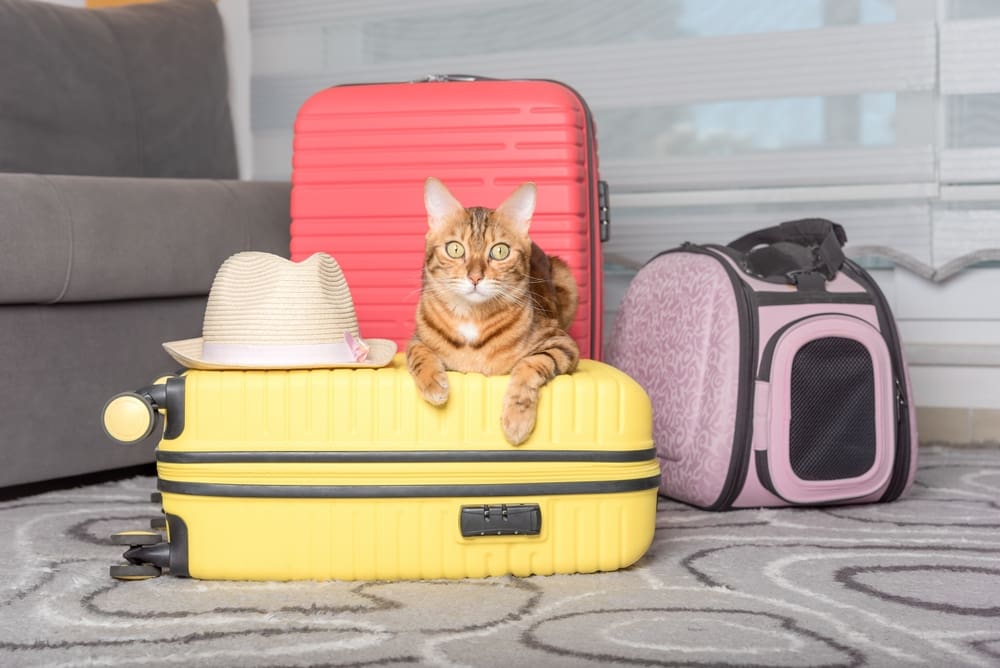Cats are cherished companions of millions in the US. Right behind dogs, they are the second most popular household pet. Like dogs, they can become an emotional support animal (ESA). In fact, countless emotional support cats are at the center of their owner’s life, providing solace when needed.
The gentle purrs and comforting presence of cats possess a therapeutic nature that helps those with mental and emotional challenges. If you have a cat, you probably have first-hand experience.
However, just because a cat provides contentment doesn’t automatically qualify them as an emotional support animal. Federal law requires cat owners to take steps to register their cats as emotional support animals.
In this article, we’ll cover everything you need to know about emotional support cats, including the laws, registering your cat as an ESA, and the benefits of having an emotional support cat.
What Is an Emotional Support Animal?
An emotional support animal is an assistance animal that provides comfort through companionship. These animals help ease the challenges of people with depression, phobias, anxiety, and other mental or emotional difficulties.
Some examples of how emotional support animals help people with troubling mental health issues are as follows.
- Providing anxiety relief
- Reducing post-traumatic stress
- Easing depression
- Distracting from negative feelings
- Alleviating loneliness
The animal in question can be any domesticated animal, including cats, dogs, ferrets, rabbits, etc. While this is pretty straightforward, simply having a cat doesn’t make them an ESA.
Those seeking an emotional support animal must get an ESA letter from their mental health provider. This letter prescribes a support animal to the person with a mental disorder or illness.
Your existing pet(s) can be an emotional support animal as long as you have this letter. Unlike service animals, ESAs don’t require training to qualify.
Disabilities That Qualify for an ESA
The common mental disabilities that may qualify you for an emotional support animal are as follows.
- Depression
- Anxiety disorders
- Chronic stress
- Post-traumatic stress disorder (PTSD)
- Attention deficit hyperactivity disorder (ADHD)
- Bipolar disorder
- Obsessive-compulsive disorder (OCD)
Those suffering from the above and other qualifying mental health issues will most certainly benefit from having an emotional support animal by their side. However, it’s up to mental health professionals to decide if an individual needs an ESA.
What Is a Service Animal?
For the most part, a service animal is a dog, regardless of breed or type, trained specifically to help someone with a qualified disability, whether physical or mental. Miniature horses can also qualify for service animal tasks, but this is very rare.
Service animals can provide emotional support, but these animals assist their handlers in daily situations they otherwise can’t perform on their own. To become a service animal, the animal must be trained to perform a task related to the handler’s disability.
There are various duties service animals uphold. Here are a few types of service dogs and how they help their handlers.
- Mobility Assistance Dogs provide assistance to individuals with physical disability. These dogs retrieve dropped items, help balance while walking, pull a wheelchair, etc.
- Hearing Dogs are trained to alert those with hearing impairment to important sounds, like doorbells, approaching vehicles, and alarm clocks.
- Psychiatric Assistance Dogs are similar to ESAs, but they take action during a psychiatric episode, such as an anxiety or panic attack, by interrupting harmful behaviors.
- Allergy Alert Dogs detect and alert their owners to allergens, such as peanuts and gluten, which can be vital to people with severe allergies.
The list of remarkable things service dogs can do goes on and on. Sadly, these are often beyond the capability of emotional support animals. They either don’t have the training or can’t be trained for such tasks.
Differences Between ESAs and Service Animals
Emotional support animals provide comfort through companionship and help owners battling mental health issues. Service animals, on the other hand, are individually trained to help their handler with a disability.
Any domesticated animal that’s a pet can become an ESA, but service animals must be a dog that received training to make the daily life of a person with a disability easier.
Cats, unfortunately, can’t be service animals. This is not due to lack of trainability or being incapable, but because the federal law doesn’t recognize them in their definition of a service animal.
So a service animal must be a dog that received training to help someone with a disability. This can be physical or mental assistance, from guiding a blind person to comforting the handler during panic attacks. An emotional support animal can be any domesticated animal that comforts the owner while battling mental health issues.
Benefits of Having an Emotional Support Cat
Just because cats can’t intervene in panic attacks or wake their owners from a nightmare doesn’t mean they can’t help their owners battling mental health issues. Although emotional support cats can’t do marvelous things service animals do, they can benefit their owners tremendously.
Emotional support cats help reduce stress and anxiety, minimize loneliness, lower blood pressure, and help their owners in many other ways. Even the simple purring of a cat can provide a sense of calm during high-stress situations. In a way, emotional support cats work as a preventative measure to ward off uncomfortable situations.
Why Cats Make Excellent Emotional Support Animals
Aside from being fantastic pets, cats make excellent emotional support animals. Their care needs are relatively low. Cats don’t require daily walking or socializing, which can be challenging for someone suffering from mental health issues.
Although countless internet memes call cats evil, they are cuddly creatures that love spending time curling up with their owners. Once you earn a cat’s trust, you will have a cuddling buddy ready to get cozy with you at any moment.
There are numerous cat breeds that come in different sizes. Often, they are much smaller than dogs. This gives them the advantage of thriving in small living areas. Even a tiny studio apartment can be large enough for most cats to live comfortably. Plus, they are quiet, and neighbors often don’t even notice their existence.
All these are a few reasons why cats are excellent emotional support animals, especially for those looking for a low-maintenance furry friend.
Is an Emotional Support Cat Right for You?


Emotional support cats have plenty of benefits and can positively impact your life. First, assess whether or not you need an emotional support cat. If you like cats and think the companionship of one would help you get better, discuss this with your mental health provider.
Although cats are low maintenance, they still need attention from their owners to live fulfilling lives. Consult a mental health provider before getting a cat. Only then it would be wise to get an emotional support cat. Otherwise, the care needs of an emotional support cat – trips to the vet, grooming, etc.– may be an added stress rather than relief.
Registering Your Cat as an ESA
The paperwork for registering your dog as an emotional support animal is straightforward. You only need to get an ESA letter from your mental health provider. This is a simple document that essentially prescribes you an emotional support animal.
There isn’t a specific law that states a maximum number to how many emotional support cats you can have. So if you have more than one cat or another pet, you can register them as emotional support animals. However, your mental health provider needs to agree that your pets are there to provide emotional support.
Having said that, registering your cat as an emotional support animal is pretty straightforward. You only need an ESA letter from your mental health provider that prescribes you an emotional support animal.
Getting an ESA Letter for Your Cat
You can only get an ESA letter for your cat through a licensed mental health professional. This can be your therapist, psychiatrist, counselor, or another licensed professional, depending on your state. Physicians can also write an ESA letter but consider that they might not be familiar with your mental health history or even emotional support animals.
You can start the process by booking an appointment with a mental health professional and requesting an ESA letter. However, it’s critical to note that the requirements vary by state.
For example, you must have a professional relationship with the mental health care worker before you can get an ESA letter in California, while Coloradans are required to obtain their ESA letter from an MD for telehealth visits, but not in person.
The specifics of the rules change confusingly by state. We can help you get an ESA letter for your cat quickly and provide consultation throughout the process.
Once a professional mental health provider signs an ESA letter, they are essentially prescribing you an emotional support animal. Obtaining this document is critical. It will not only validate your cat as an emotional support animal, but you will also have the necessary documents to prove that your cat is there to support you emotionally.
You may need your ESA letter to prove your cat isn’t an ordinary pet cat, which a future landlord or establishments that only allow ESAs might ask.
Myths About Emotional Support Animals
- Anyone Can Get an ESA: Any person can get a loving pet that provides them emotional support. However, not everyone can get an ESA just as they can get a pet. A mental health professional must prescribe an emotional support animal to help those suffering from mental illnesses and disorders.
- You Can Go Everywhere With an ESA: Unlike service animals, ESAs can’t enter places where pets are prohibited. In the past, ESAs, like service animals, could enter spaces with no-pet policies. That changed, and ESAs now must abide by the pet policies, except when renting a property.
- They Must Wear ESA Vests in Public: There is no mandate that requires ESAs to wear vests that prove their status. It’s entirely up to the owner to decide if their emotional support animal wears an ESA vest.
- All Animals Can Be ESAs: Only domesticated animals can be emotional support animals. Pet snakes, lizards, and other non-domesticated wild animals can’t qualify as an ESA.
- ESAs Must Follow Landlord’s Pet Policies: Under federal law, landlords can’t discriminate against people who have ESAs, regardless of their pet policy, which brings us to our next point.
Renting a Property With an Emotional Support Cat
Emotional support cats don’t have the same protection as service animals, such as being able to fly with their owner for free. However, they still have a place in the law.
Federal law protects people with disabilities to have emotional support cats when renting a property. The Fair Housing Act (FHA) clearly states that landlords can’t discriminate against tenants with an emotional support animal.
Even if the building has a strict no-pet policy, you can rent a property and keep your emotional support cat. Furthermore, landlords can’t request an extra deposit or a fee for an emotional support animal like they can for an ordinary pet.
However, your landlord is likely to ask for proof of your cat’s ESA status – make sure to have the ESA letter ready.
Flying With an Emotional Support Cat


The rules for flying with an emotional support animal are straightforward but due to outdated information revolving around the internet, it can get confusing.
The Air Carrier Access Act allowed emotional support animals to fly with their owners for free in the past. That changed on December 2, 2020. With the revised law, the Department of Transportation now only requires airlines to accept service animals to fly with their owners.
Since emotional support cats can’t be service animals, they must follow the airline’s pet policies. Luckily for emotional support cat owners, most cats are far below the weight limit to fly in the cabin, which is often 20 pounds. You can fly with your emotional support cat in the cabin for a modest fee and by booking in advance.
However, you can’t take your cat out of their carrier bag during the flight. The airline may also not accept your emotional support cat if there are too many pets in the cabin. To make sure everything goes smoothly before and after your flight with an emotional support cat, consider the following tips.
7 Tips for Flying With Your Emotional Support Cat
- Book tickets in advance
- Have your emotional support cat’s paperwork ready
- Check airline’s pet carrier requirements
- Pack essential supplies
- Arrive at the airport early
- Avoid feeding four to six hours before the flight
- Check special requirements for international flights (vaccines, titer test, etc.)
FAQs
What Is the Best Cat Breed for an ESA?
There isn’t one cat breed that fits every individual seeking an emotional support cat. Different cat breeds have varying personalities, temperaments, energy levels, and sizes.
Finding the best cat breed for an ESA depends on your individual preferences. Still, ragdoll, Maine coon, Siamese, British shorthair, Manx, and Sphynx are among the popular emotional support cat breeds.
Can Cats Understand Our Emotions?
Cats are instinctively observant and perceptive animals that can detect changes in a human’s emotions. Although they may not understand the complexity of our feelings, they can sense depression or sadness and may curl up next to you, purr, or rub against you to provide comfort.
Does Cat Purring Help With Depression?
Cat purring has proven to be beneficial to humans as it is to cats. Their soft rumble has been shown to relax humans and promote the release of endorphins. It’s an effective mood booster that can help with depression and immediately reduce stress.
Emotional Support Cats Are Amazing
Emotional support cats are wonderful four-legged creatures. Cats are sensitive to our emotions and consider their fur parents a part of their colony. Naturally, they want to ensure our well-being.
Although they can’t perform the tasks of service animals, emotional support cats improve the quality of their owner’s life by reducing stress and anxiety. Plus, they don’t expect much from their owner. As long as they have a full belly and receive compassion, they will stay by their owner to provide emotional support.
You can obtain an ESA letter from your licensed mental health professional or book an online consultation with us to help you get your ESA letter for your cat ASAP.




